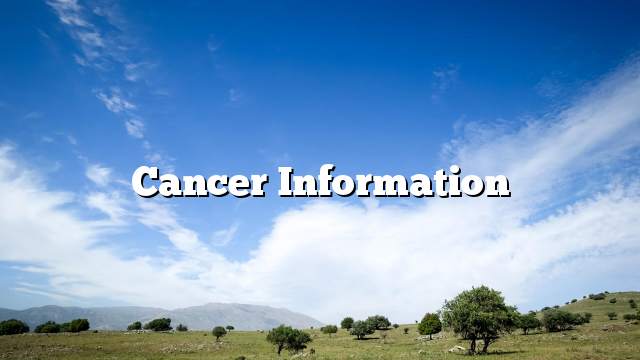cancer
Cancer is defined as abnormal growth of cell tissues in the body, spreading uncontrollably, and it must be noted that it affects different parts of the body, where the symptoms vary according to the tissue or organ affected, although it may spread to all members of the body, By invading the growing cells surrounding tissues causing the tumors appear in different places of the body, may be far from the infected member, and in this article will inform you more about this disease.
Cancer Information
Types of cancerous diseases
- Polyps: They are tumors that are coated with fibrous tissue, are non-spreadable, easy to dispose of, and are no longer re-removed after they have been removed by surgical intervention, especially in the case of large tumors or which pose a burden or danger to the affected member or organs nearby. And prevent them from functioning normally, and these tumors may turn into malignant tumors, such as colorectal tumor in the colon, which turns to colon cancer if not treated in the early stages.
- Malignant tumors: Are tumors in which abnormal cells multiply significantly, and non-stop control of the infected organ, and may spread to other members of the body through both the lymphatic and bloody, and there are more than a hundred types of cancer, which vary according to the fabric composition, such as: Cancer Liver, breast cancer, and chronic and severe chronic leukemia.
- Note: Cancer affects people of all ages, but the risk increases with the age of man, although there are types that may affect the animal and plants as well as human.
Causes of healthy cells turning into cancerous cells
- Infection of a bacterial or viral infection, such as infection caused by hepatitis C or B.
- Pre-existing family history of the disease.
- Exposure to a carcinogen, such as radiation, smoking, or carcinogenic chemicals such as: asbestos used in construction, external and internal insulators, roofing of houses, drainage pipes, ventilation and fumes.
- Alcoholic beverages.
- Changes in genetic material are inherited, and these mutations or changes in two types of genes are:
- Genes and tumors: They are active genes in the cancer cell, that is, genes that acquire new properties, such as: division, growth, or growth in abnormal circumstances.
- Resistant genes are genes that stop in the case of a cancer cell because they oppose its formation by correcting any error in DNA replication. It monitors cell division, contributes to cell fusion and does not transfer, and helps the immune system protect the tissue.
Symptoms of cancer
Topical symptoms
- Excessive bleeding or runny nose of the body.
- The appearance of TSMC or block anywhere in the body, such as a woman’s breast.
- Change in mole size or color.
- Ulcers that do not respond to treatment within a maximum of 20 days.
- Change the color of the eye, yellowing, or skin.
Transient symptoms
- An unpleasant cough or cold does not respond to treatment, especially if it coincides with the exit of blood from the throat.
- Difficulty in digestion, difficulty swallowing.
- Change in urination or urination habits.
- Infection of the liver.
- Feeling of pain in the bones.
- Inflammation of the lymph nodes.
Symptoms appear throughout the body
- A significant weight loss and no known causes, such as a 10% reduction in weight within 6 months.
- Excessive sweating especially at night.
- Anorexia.
- Feeling tired and tired.
- Anemia.
How to Diagnose Cancer
- Identify symptoms, and identify them.
- Perform a medical test, such as a laboratory blood test.
- Computed tomography.
- Endoscopy.
- Make a CT scan of the patient.
- Taking a sample or biopsy of the disease, so as to identify the stage and degree of cancer,
Ways to treat cancer
Surgical treatment
Solid cancers can be eliminated by surgical removal, but this becomes impossible after the disease spreads to more than one place in the body. These cancers initially grow in place, then migrate to the lymph nodes and then spread to all organs of the body , Which requires the search for topical treatments for cancer cells before they spread, such as: surgery to remove breast tumor, or prostatectomy.
Radiation therapy
This treatment depends on the use of the ability of radiation in the ionization of cancer cells, in order to reduce the number or to kill, which is applied to the body from the outside in the treatment of the treatment of external beam, or on the body from the inside in what is known as treatment branch, It should be noted that this treatment affects both diseased and healthy cells, but the ability of healthy cells to recover from the impact of radiation is greater, So the doctor resorted to fragmentation This treatment to several doses, in order to give healthy cells the ability to recover, and it must be noted that this treatment is used to treat all types of solid cancer, in addition to leukemia.
Chemotherapy
This treatment depends on the chemical drugs that have the ability to destroy cancer cells and kill her, where these drugs affect all fast-dividing cells, knowing that this treatment interferes with cell division in different regions, such as overlap when configuring the chromosomes must be noted that this The drugs target all cells of the body, but healthy cells have greater ability to try to repair the damage.
Immunotherapy
This treatment is designed to stimulate the immune system in the patient’s body to fight cancer cells, by generating immune response against the disease, such as the use of a certain type of drugs to stimulate the immune system against the type of cancer suffered by the patient.
Hormonal therapy
This treatment depends on the effect of hormones, by disabling or removing them, such as estrogen or estrogen. It should be noted that this type of treatment is used for certain types of cancers such as prostate cancer or breast cancer.
